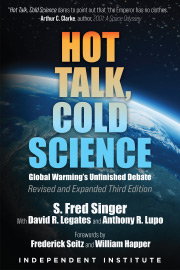The release in August of the Intergovernmental Panel on Climate Change’s sixth assessment report on climate change and its summary for policymakers, has prompted the media to report that it is “code red” for the planet. The reaction from many people was one of genuine alarm. But does the report really provide anything new or alarming? Several of the most overstated findings have been presented already in one form or another since the fifth assessment report came out in 2014.
The summary follows the pattern of those in past assessment reports by presenting results meant to get the maximum attention from politicians and the media. One of the first findings in the latest one is that the previous decade’s mean global temperature was 0.8 – 1.3 degrees Celsius warmer than the late 19th century temperatures, with a best estimate of 1.07 degrees Celsius. But this result is not newsworthy. We’ve heard it many times in relation to the 1.5 degree Celsius so-called target for limiting global warming as given by the IPCC. Almost everyone concedes it is warmer today than it was in the late 19th century, but we still cannot be entirely sure how much warmer. The report presents the finding as likely, with 66 -100 percent confidence if you read the fine print. The lower end of the likely confidence range would not pass peer review.
Unfortunately, the hockey stick graph, showing the global mean temperature as steady for the last millennium except with a large increase during the 20th century, makes an appearance in the current report, even though it is an old and discredited claim. Nonetheless, it is used to show, with the help of climate models, that the warming of the last century was very likely caused by humans. Many things are wrong with this experiment modeling the global temperature of the late 19th and 20th centuries, not the least is that climate models tend to suggest more warming than is observed, even over shorter time periods according to two recently published peer-reviewed studies.
Another figure shows a global map of land-based regional changes and trends in warm extremes, heavy precipitation, and drought—information presented since the last report. The figure is color-coded and at first glance shows these changes as fairly widespread globally. But the details show that the high degree of confidence in the readily measurable increase in warm extremes for many places is to be expected regardless of whether humans caused the increase or not.
Similarly, the map showing trends in heavy precipitation and drought is presented in green and yellow indicating increased frequencies around the globe. However, the fine print reveals the low confidence in almost all of these results. The highest confidence expressed in very few instances is only “medium”. Recently published papers addressing drought show little in the way of a trend worldwide since the mid-20th century. There is only some indication of regional drought trends that are related to long-term cycles.
Many more problems with the summary for policymakers could be listed, and in the coming months, various researchers will point these out. One of the most pervasive problems is that the summary tends to highlight the scenarios assuming medium-to-high end estimates of future carbon dioxide emissions, ignoring the full range of potential futures.
Using these scenarios accelerates the timeline for the global mean temperature to reach the 1.5 degree Celsius target sooner than expected. If one wants to see the full range of projected scenarios that has been published in the scientific literature, one must be willing to search through the nearly 4,000 pages of the report.
This is not to say that the climate is not changing and that nothing can be done about it. Human adaptation to climate change has worked for millennia, and our society is the most technologically advanced in history. But, many of us feel that adaptation is best done through free human ingenuity rather than government mandates.









